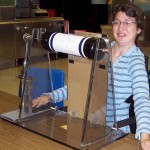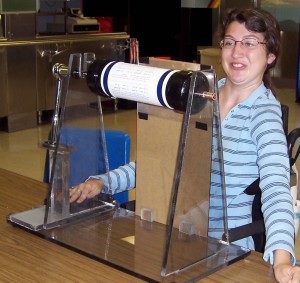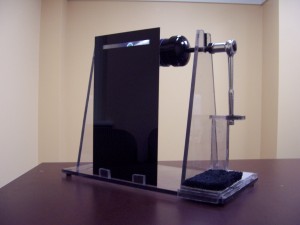Designers: Oluwaseun Omofoye and Akef Rahman
Client Coordinators: Caroline Banka
INTRODUCTION:
Our client is a girl with a traumatic brain injury, who has difficulty in isolating lines and reading small fonts while she reads. This injury also affects her motor control, and consequently, she has spastic movements. Due to our client’s slow speed in reading, she usually reads about a page in 30 minutes or more. We developed a mechanical reading aid that isolates 1-2 lines of text, and allows her to easily scroll through the page.
SUMMARY OF IMPACT:
The client’s mother says that, “the reading aid has made it possible for our daughter to read independently because it isolates and magnifies one line of text at a time, and she can move to the next line of text fairly easily. Before someone needed to hold the book and isolate the text with a piece of paper. She has ataxia, so it isn’t easy for her to move flimsy objects, but the reading aid is so sturdy that she can move from one line to the next with little effort.”
TECHNICAL DESCRIPTION:
The reading aid consists of a rotating cylinder that is mounted on a stand. A ratchet is attached to the cylinder. The client pushes on an acrylic platform, which pushes the ratchet handle and rotates the cylinder to the next line. A black piece of acrylic shields the rotating cylinder so that it is not a distraction to the client. However, there is a rectangular window in the acrylic, which reveals 1-2 lines on the page at a time. A Fresnel lens is mounted to the window in order to magnify the text.
The cylinder consists of a PVC pipe of radius 1.75 inches, and two PVC caps with holes at the center are attached to the ends of the pipe. The length of the pipe and caps is about 15 inches. Copper pipe goes through the center to form an axle. The PVC pipe and exposed parts of the copper axle are painted black.
The side supports and base of the reading aid are made out of Lexan, a strong and durable polymer. All of the Lexan pieces are removable, so that the device can be easily assembled and disassembled for portability. The different Lexan shapes were milled and cut from a 4 by 2 feet, 0.5 inch thick sheet. The rough edges and surface scratches of the Lexan were blowtorched for smoothness.
The client advances the text using a ratcheting mechanism. The ratchet converts motion in a linear direction to a rotation of the cylinder, and it also allows for rotation in both clockwise and anticlockwise directions. The ratchet allows the reading aid to be rotated in the direction of interest, and remain motionless when the ratchet is rotated back to its starting position. If the reading aid needs to be rotated in the opposite direction then the switch on the ratchet can be turned, reversing the ratcheting direction. The ratchet is a standard commercial ratchet with a 12” long handle. The copper axle is soldered to a standard ratchet socket and this socket snaps into the ratchet.
The total cost of this device is approximately $440.




University Operator: (919) 962-2211 | © 2024 The University of North Carolina at Chapel Hill |